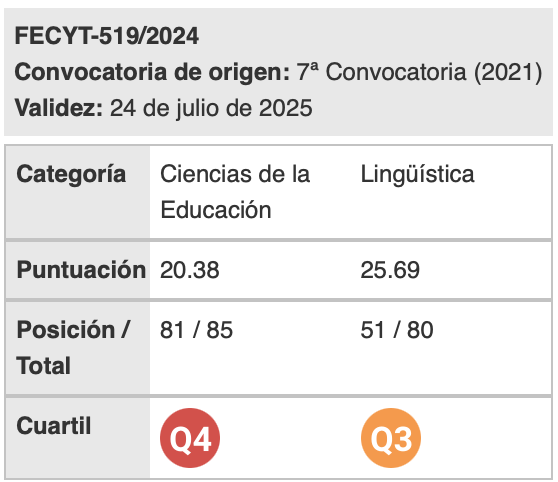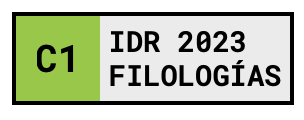Learning and improvement of languages: subtitling in the Primary Education Teacher's Degree
Keywords:
Subtitling, higher education, language learning, ICT, teaching, mother tongueAbstract
The aim of this study is to analyse the role of subtitling when learning a foreign language ─English─, and improving mother tongue. Besides, subjects ─a group of third year Primary Education undergraduates─ assess the role subtitles could play in the classroom. A questionnaire was used to collected data, which suggest that subtitling is a really useful tool forgrammar and vocabulary acquisition, as well as for improving writing skills. Furthermore, they remark the importance of ICT and self-learningwhen teaching both a foreign language and a mother tongue. For another thing, trainee teachers’ opinions give the chance to exploresubtitles didactic role in a primary class.
Downloads
References
Araújo, Vera Lucia Santiago (2008). The educational use of subtitled films in EFL teaching. En J. Díaz Cintas (Ed.), The Didactics of Audiovisual Translation. (pp. 227-238) Amsterdam/Filadelfia: John Benjamins.
Barbería, José Luis (19 de octubre de 2008). Mucho título y pocas letras. El País. Recuperado de https://bit.ly/2tsew9e Bisquerra, R. (1989). Métodos de investigación educative: Guía práctica. Barcelona: Ceac ediciones.
Borrás, Isabel y Lafayette, Robert (1994). Effects of multimedia courseware subtitling on the speaking performance of college students of French. The Modern Language Journal, 78(1), 61-75.
Bravo, Maria Conceiçao Condinho (2008). Putting the Reader in the Picture: Screen translation and foreign language learning.
Tesis doctoral presentada en la Universitat Rovira i Virgili, Tarragona.
Caimi, Annamaria (2006). Audiovisual Translation and Language Learning: The Promotion of Intralingual Subtitles. JoSTrans, The Journal of Specialised Translation, 6, 85-98.
Čepon, Slavica (2011). Interlingual Subtitling as a Mode of Facilitating Incidental Foreign Language Acquisition. English for Specific Purposes World, 33(11). <http://www.esp-world.info/Articles_33/Issue_33.htm> [6/6/2017]
Chaume, Frederic (2004). Cine y traducción. Madrid: Cátedra Ediciones.
Consejo de Europa (2001). Marco común europeo de referencia para las lenguas: aprendizaje, enseñanza y evaluación.
Cambridge: Cambridge University Press.
Cummins, Jim (1979). Linguistic Interdependence and the Educational Development of Bilingual Children. Review of Educational Research, 49(2), 222-251.
Cummins, Jim (2007). Rethinking monolingual instructional strategies in multilingual classrooms. Canadian Journal of Applied Linguistics / Revue canadienne de linguistique aplliquée, 10(2), 221-240.
d’Ydewalle, Géry; Pavakanun, Ubolwanna (1997). Could enjoying a movie lead to language acquisition?. En P. Winterhoff- Spurk; T. Van der Voort (Eds.), New Horizons in Media Psychology (pp. 145-155). Opladen, Alemania: Westdeutscher- Verlag GmbH.
Daborn, John (1960). Cine Titling. Londres: Fountain Press.
Danan, Martine (1992). Reversed subtitling and dual coding theory: New directions for foreign language instruction.
Language Learning 42(4), 497-527.
Díaz Cintas, Jorge (2003). Teoría y práctica de la subtitulación (Inglés-Español). Barcelona: Ariel.
Díaz Cintas, Jorge. (2010). Subtitling. En: Y. Gambier y L. Van Doorslaer. (Eds.), Handbook of translation studies. (pp. 344-
Manchester: St. Jerome.
Díaz Cintas, Jorge (2012). Los subtítulos y la subtitulación en la clase de lengua extranjera. Abehache, Revista da Associação Brasileira de Hispanistas, 3(2), 95-114.
Díaz de Greñu, Sofía (2017). Competencias instrumentales en torno a las tecnologías digitales en el inicio de la formación universitaria. En Alfonso Gutiérrez, Agustín García y Rocío Collado (eds.) Educación Mediática y Competencia Digital. Aportaciones (Actas del III Congreso Internacional de Educación Mediática y Competencias Digital). (pp. 540-556) Valladolid: Universidad de Valladolid.
Esteve, Francesc; Adell, Jordi; Llopis, Mª Ángeles y Valdeolivas, Mª Gracia (2017). El desarrollo de la competencia digital docente en los grados de Maestro/a de Educación Infantil y Primaria: descripción de una experiencia didáctica. En Alfonso Gutiérrez, Agustín García y Rocío Collado (eds.) Educación Mediática y Competencia Digital. Aportaciones (Actas del III Congreso Internacional de Educación Mediática y Competencias Digital). (pp. 962-973) Valladolid: Universidad de Valladolid.
González-Iglesias, Juan David. (2012). Desarrollo de una herramienta de análisis de los parámetros técnicos de los subtítulos y estudio diacrónico de series estadounidenses de televisión en DVD. Tesis doctoral presentada en la Universidad de Salamanca.
Incalcaterra McLoughlin, Laura y Lertola, Jennifer (2011). Learn through subtitling: subtitling as an aid to language learning. En L. Incalcaterra McLoughlin, M. Biscio y M. A. Ní Mhainnín (Eds.), Audiovisual Translation: Subtitles and Subtitling. Theory and Practice (pp. 243-263). Oxford: Peter Lang.
Kelly, Dorothy (2002). Un modelo de competencia traductora: bases para el diseño curricular. Puentes: Hacia nuevas investigaciones en la mediación intercultural, 1. (pp. 9-21) Granada: Comares.
Koolstra, Cees M.y Beentjes, Johanna W.J. (1999). Children’s vocabulary acquisition in a foreign language through watching
subtitled televisión programs at home. Educational Technology Research and Development, 47, 51-60.
Kothari, Brij; Avinash, Pandey y Chudgar, Anita R. (2004). Reading out of the ‘idiot box’: Same-language subtitling on television in India. Information Technologies and International Development 2(1), 23-44.
Krashen, Stephen. (1987). Principles and Practice in Second Language Acquisition. Exeter: Prentice-Hall International.
Lertola, J. (2013). Subtitling New Media: Audiovisual Translation and Second Language Acquisition. Tesis doctoral presentada en la National University of Ireland, Galway
Lertola, Jennifer (2012). The effect of the subtitling task on vocabulary learning. En Anthony Pym y David Orrego-Carmona (eds.): Translation Research Projects, 4. (pp. 61-70) Tarragona: Universitat Rovira i Virgili.
López Cirugeda, Isabel y Sánchez Ruiz, Raquel (2013). Subtitiling as a Didactic Tool. A Teacher Training Experience. Porta Linguarum, 20, 45-62.
Malmkjaer, Kirsten (Ed.) (1998). Translation and Language Teaching: Language Teaching and Translation. Manchester: St.
Jerome.
Manyak, Patrick C. (2004). ‘What did he say?’ Translation in a primary-grade English immersion class. Multicultural Perspectives, 6, 12-18.
Marín, Diana; Morote, Diana y Granados, Jesús (2017). Percepción de un grupo de alumnos de magisterio sobre su competencia digital: un estudio piloto. En Alfonso Gutiérrez, Agustín García y Rocío Collado (eds.) Educación Mediática y Competencia Digital. Aportaciones (Actas del III Congreso Internacional de Educación Mediática y Competencias Digital). (pp. 165-172) Valladolid: Universidad de Valladolid.
Marzà, Anna y Torralba, Gloria (2015). Incidental language learning through subtitled cartoons: is it possible in a dubbing country? En Y. Gambier; A. Caimi y C. Mariotti (Eds.), Subtitles and Language Learning (pp. 199-220). Berna: Peter Lang.
Ministerio de Educación, Cultura y Deporte. (2016) PISA 2015. Programa para la Evaluación Internacional de los Alumnos.
Informe Español. Madrid.
Ministerio de Educación, Cultura y Deporte. (2017) PIRLS 2016. Estudio internacional de progreso en comprensión lectora.
IEA. Informe Español. Madrid.
Parks, Carolyn (1994). Closed captioned TV: A resource for ESL literacy education. ERIC Digest, ED 372 662. www.ericdigests.org/1995-1/tv.htm [5/5/2017]
Pavakanun, Ubolwanna y d’Ydewalle, Géry (1992). Watching foreign televisión programs and language learning. Cognitive Modelling and Interactive Environments in Language Learning, 1, 193-198.
Prabhu, N. S. (1987): Second Language Pedagogy. Oxford: Oxford University Press.
Romero-Fresco, Pablo (2009). More Haste Less Speed: edited vs verbatim respeaking. Special issue of Vigo International Journal of Applied Linguistics (VIAL), VI, 109-133.
Sokoli, Stavroula. (2006). Learning via Subtitling (LvS): A tool for the creation of foreign language learning activities based on film subtitling. Actas MuTra 2006 – Multidimensional Translation: Audiovisual Translation Scenarios. Copenhague: Universidad de Copenhague.
Talaván, Noa. (2009). Aplicaciones de la traducción audiovisual para mejorar la comprensión oral de inglés. Tesis doctoral presentada en la Facultad de Filología de la Universidad de Educación a Distancia (UNED)
Talaván, Noa (2011). A quasi-experimental research project on subtitling and foreign language acquisition. En L. Incalcaterra McLoughlin, M. Biscio y M. A. Ní Mhainnín (Eds.), Audiovisual Translation: Subtitles and Subtitling. Theory and Practice. (pp. 197-217). Oxford: Peter Lang.
Talaván, Noa (2013). La subtitulación en el aprendizaje de lenguas extranjeras. Barcelona: Octaedro.
Torralba, Gloria (2016). L’aprenentatge de llengües a través de la traducció audiovisual: la subtitulació com a eina per a l’adquisició de lèxic en llengua estrangera. Tesis doctoral presentada en la Facultat de Ciències Humanes i Socials de la Universitat Jaume I.
Torregrosa, Carmen (1996). Subtítulos: traducir los márgenes de la imagen. Sendebar, 7, 73-88.
Universidad Internacional de Valencia (18 de marzo de 2015). Reino Unido y España encabezan el ranking europeo de ordenadores por alumno y de uso de las TIC en el aula. [Blog] Recuperado de https://bit.ly/2trgcQp
Van de Poel, Marijke y d’Ydewalle, Géry (1999). Incidental foreign-language acquisition by children watching subtitled television programs. Journal of Psycholinguistic Research 28, 227-244. Reimpreso en: Y. Gambier; H. Gottlieb (Eds.) (2001). (Multi)Media Translation. Concepts, Practices, and Research (pp. 259-273). Amsterdam y Philadelphia: John Benjamins.
Vanderplank, Robert (1988). The value of teletext sub-titles in language learning. ELT Journal, 42 (4), 272-281. Willis, Jane (1996): A Framework for Task-Based Learning. Essex: Longman Harlow.
Filmografía
Maggie and the Ferocious Beast. Michael y Betty Paraskevas. Serie de animación. Nelvana Productions, 2000-2003.
Downloads
Published
How to Cite
Issue
Section
License
Authors who publish with this journal agree to the following terms:
- Authors retain copyright and grant the journal right of first publication with the work simultaneously licensed under a Creative Commons Attribution License that allows others to share the work with an acknowledgement of the work's authorship and initial publication in this journal.
- Authors are able to enter into separate, additional contractual arrangements for the non-exclusive distribution of the journal's published version of the work (e.g., post it to an institutional repository or publish it in a book), with an acknowledgement of its initial publication in this journal.
- Authors are permitted and encouraged to post their work online (e.g., in institutional repositories or on their website) prior to and during the submission process, as it can lead to productive exchanges, as well as earlier and greater citation of published work (See The Effect of Open Access).

Revista de Lenguas para fines específicos is licensed under a Creative Commons Reconocimiento-NoComercial-SinObraDerivada 4.0 Internacional License.
























